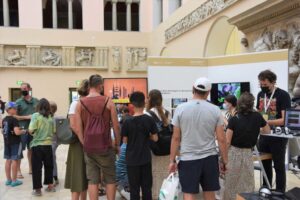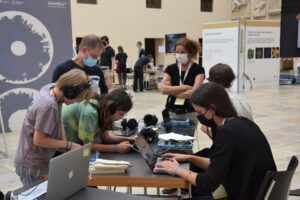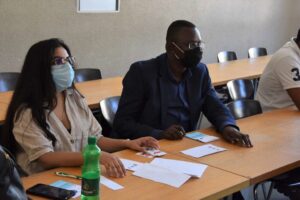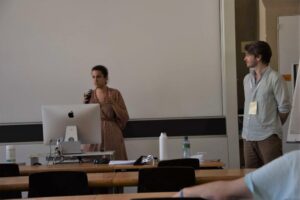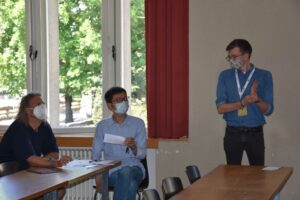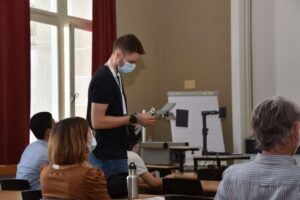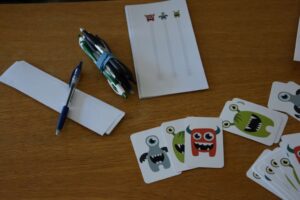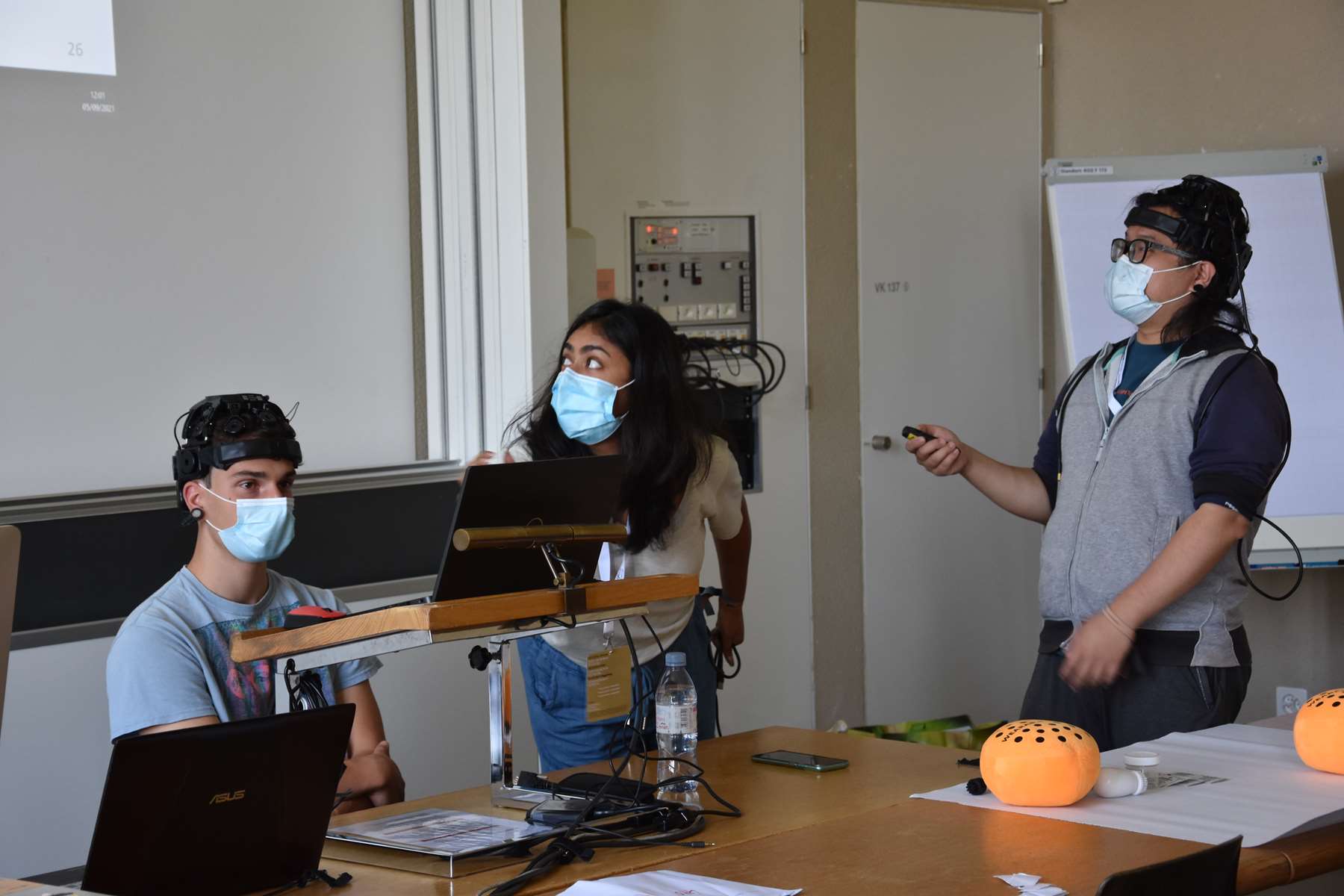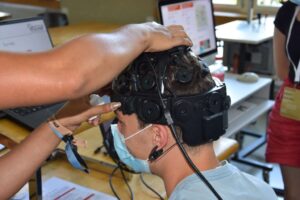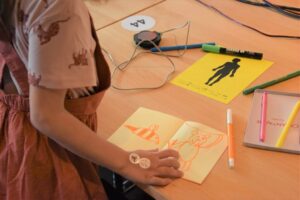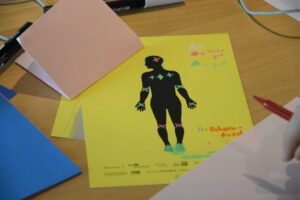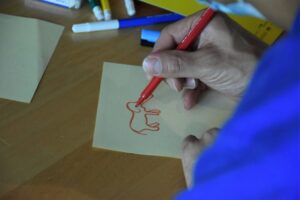Scientifica 2021 – When researchers meet the public
The NCCR Evolving Language community took actively part in Scientifica, the science fair held by the University of Zurich and ETH Zurich on September 4-5. By visiting our booths, visitors had the chance to discover how emotions sound in animal, human and machines vocalizations, to learn what linguistic and communicative abilities monkeys and meerkats share with us and to test a video game that facilitates reading acquisition. We also organized several workshops that were the unique opportunity to understand how computers could decode our minds, to play a series of «artificial grammar learning» games, exploring how different innovations are transmitted according to their suitability for language learning and use and to test how your body “physically” feels the properties of sound. Finally, we organized a Science Café on the topic of animal “culture”.
Content of activities
Exhibition booths
Evolving Language is an interdisciplinary consortium that brings together researchers from different fields. As it is not always clear how these fields are all connected, we decided to create a movie that links our three booths. The movie was displayed during the entirety of the event.
From Natural to Synthetic: An emotional exploration of Animal, Human and AI expressions
Nicole Tamer, Nikola Falk
What do the emotions of animals, humans and machines sound like?
The expression of emotions plays a major role in the communication of humans and animals. But machines are also becoming better at imitating emotions. To find out how the emotions of animals, humans and machines sound, try our online-quiz!
Animal “language”? What are animals saying and what do they understand?
Simon W. Townsend, Piera Filippi, Alexandra Bosshard, Maël Leroux, Joseph Mine, Franziska Wegdell, Manuel Rüdisühli, Silvan Spiess
What do animal calls mean? Can animals combine sounds in a way that, at least superficially, resembles human language? Do animals share basic “language” abilities with humans? Our research deals with such questions. For this purpose, we listen to the animals, and record their calls and behaviour. We also play back their own calls to them, or create synthesised, naturalistic, and artificial sounds to observe how the animals react to them.
EduGame: leveraging game-based technologies to facilitate reading acquisition
Martina Röthlisberger, Angela Pasqualotto, Timothy Piton
Efficient reading skills are not only important for a child’s academic career but are also fundamental for numerous situations in every-day life. A weakness in this area is also associated with a number of other negative consequences across the lifespan, such as an enhanced risk of psychological distress and mental health problems. Thus, developing proper training strategies for acquiring literacy is a goal of utmost importance.
Our aim is to leverage game-based technology to facilitate reading acquisition in a playful way. For this reason, we present two video games that we have developed to train reading and reading-related skills in elementary school children.
The Swiss GraphoLearn App – University of Jyväskylä (Fi) and Department of Child and Adolescent Psychiatry and Psychotherapy (U. Zurich)
GraphoLearn promotes reading skills by intensely training the correspondence between print and speech starting with simple letters followed by syllables, word parts, words, and short sentences and longer text units. It is designed as a series of distinct, specialized, adaptive and child-friendly mini-games.
Skies of Manawak – University of Trento (IT) and Bavelierlab (U. Geneva)
Skies of Manawak promotes reading skills through training attentional control and several facets of EFs known to be crucial for reading. It is designed as a video game with a unifying story arc and adaptive activities linked through a video game with action-based mechanics.
Workshops Language evolves! From the primate brain to the linguistic community
Across the globe, humanity flourishes by sharing thoughts, culture, information and technology through language – an incredibly complex method of communication shared with no other species on Earth. Languages themselves are dynamic systems which evolve through the introduction of new words and conventions by their users. These innovations are transmitted to other users during communication and then onwards to new generations of speakers during learning, ultimately changing the linguistic system over time. However, not all innovations are equally likely to be transmitted; those which better fit the needs of the language learner and user might be more readily passed on.
In this workshop we introduced the scientific study of language evolution through a series of «artificial grammar learning» games, exploring how different innovations are transmitted according to their suitability for language learning and use. We further explored how this suitability is dependent on the processing capacities of learners and users, and how determining the extent to which these capabilities are shared by our sister primate species, or are instead uniquely human, can shed light on the evolutionary journey that led us to language.
Stuart Watson, Carmen Saldana. With support from Alec Shaw, Théophane Piette
Can a computer extract speech directly from the brain signals?
Every year thousands of people lose their ability to communicate due to neurological disorders caused by damage in speech-related brain areas (such as in aphasia) or paralysis of voluntary muscle movement (such as in locked-in syndrome). The consequences of the disruption of natural speech production on the life quality of such patients are devastating. Therefore, we aim at establishing a bridge between the brain and a computer that would allow participants to interact with the external world using only their brain activity, bypassing the need for speaking aloud. We call such a system a Brain-Computer Interface (BCI). To collect brain signals, we use electroencephalography (EEG)- a non-invasive technology where recording sensors are placed at different locations over the scalp.
During the experiment, we ask the participant to imagine pronouncing two different speech units without speaking aloud. Our BCI system then collects their EEG data and tries to distinguish the signal from the two speech units. The participants are then asked to do the same task again as before while the BCI system will give a prediction of the “mind” in their brain. The goal of this research is to better understand the neural mechanisms involved in human speech processing that in the long term might provide rehabilitation solutions for patients with compromised speech functions. At Scientifica 2021, we demonstrated our ongoing speech-BCI experiment to give visitors a feel of how a scientific experiment of this kind is carried out.
Kinkini Bhadra, Shizhe Wu. With support from Amelie Haugg & Chantal Oderbolz
Let your body vibrate to feel the communication!
Have you ever experimented with sound being diffused through your entire body? Are you curious to test your vibrational sensing abilities?
In this workshop, participants were able to test how their body “physically” feels the properties of sound; by using a transducer – a vibrating speaker – they were able to make their own body vibrate to sounds ranging from your own voice – speaking, singing, grunting – to animal vocalisations. At the end of the workshop, participants were invited to draw their perception of this embodied experience on a large board which became a collective fresco representing all the traces of the vibrations felt during the day. A unique emotional and physical experience, opening up horizons for a new form of communication!
Julie Semoroz, Aude Barrio, Didier Grandjean, Carole Varone
Scientifica Café Can animals really have culture?
About the “culture war” over the existence of culture in non-human animals
Culture is traditionally perceived as an artificial product and thereby contrasted with nature. It is also widely regarded as a prerogative of humans. However, recent developments in cognitive ethology, anthropology and ethnology cast doubt on these claims. As a result, there has been a veritable ‘culture war’ among experts. The controversy ranges over questions like: How should culture be defined? In what sense and to what extent are non-human animals capable of cultural achievements like behavioral traditions and the production of artefacts? Is there anything in the domain of culture that distinguishes humans from animals, e.g. a capacity for cumulative cultural evolution? And what impact should animal culture have for our culture of treating animals? We illustrated and discussed these questions through posters and a panel discussion.
Panelists:
- Professor Dr. Hans-Johann Glock (Organisation), Dept. of Philosophy UZH and NCCR Evolving Language UZH
- Dr. Stuart Watson, Vergleichende Sprachwissenschaft UZH and NCCR Evolving Language
- Professor Dr. Markus Wild, Dept. Of Philosophy University of Basel and NCCR Evolving Language, Moderation
Poster by: Raphael Schwere, Völkerkundemuseum UZH









